BS 2: Respiratory System Case Study: Patient CB, February 2020
VerifiedAdded on 2022/08/12
|11
|2947
|23
Case Study
AI Summary
This case study analyzes the respiratory system issues experienced by patient CB, focusing on his symptoms of cough and shortness of breath, exacerbated by smoking. The study delves into the structure and function of the respiratory system, explaining alterations in normal functioning and potential health issues. It examines diagnostic tests, including pulmonary function tests, electrocardiograms, and arterial blood gas analysis, to assess the patient's condition. The case study also outlines nursing interventions, such as respiratory assessments, breathing exercises, patient education on smoking and hygiene, and emotional support to improve the patient's health outcomes. The analysis considers the patient's history of hypertension and hyperlipidemia, emphasizing the importance of comprehensive care and interventions.

Running Head: BS 0
Issues of body system
FEBRUARY 16, 2020
Issues of body system
FEBRUARY 16, 2020
Paraphrase This Document
Need a fresh take? Get an instant paraphrase of this document with our AI Paraphraser
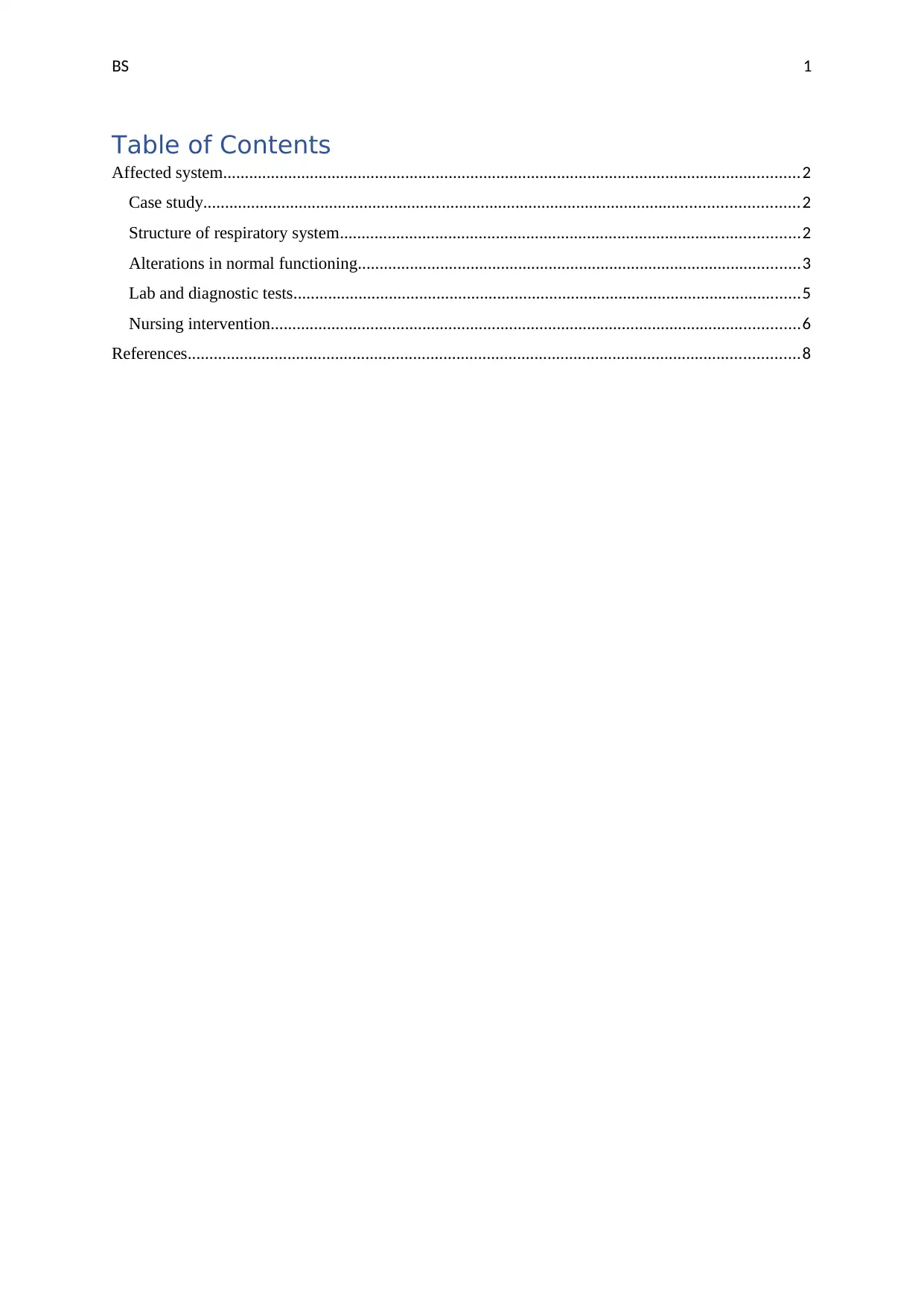
BS 1
Table of Contents
Affected system.....................................................................................................................................2
Case study.........................................................................................................................................2
Structure of respiratory system..........................................................................................................2
Alterations in normal functioning......................................................................................................3
Lab and diagnostic tests.....................................................................................................................5
Nursing intervention..........................................................................................................................6
References.............................................................................................................................................8
Table of Contents
Affected system.....................................................................................................................................2
Case study.........................................................................................................................................2
Structure of respiratory system..........................................................................................................2
Alterations in normal functioning......................................................................................................3
Lab and diagnostic tests.....................................................................................................................5
Nursing intervention..........................................................................................................................6
References.............................................................................................................................................8
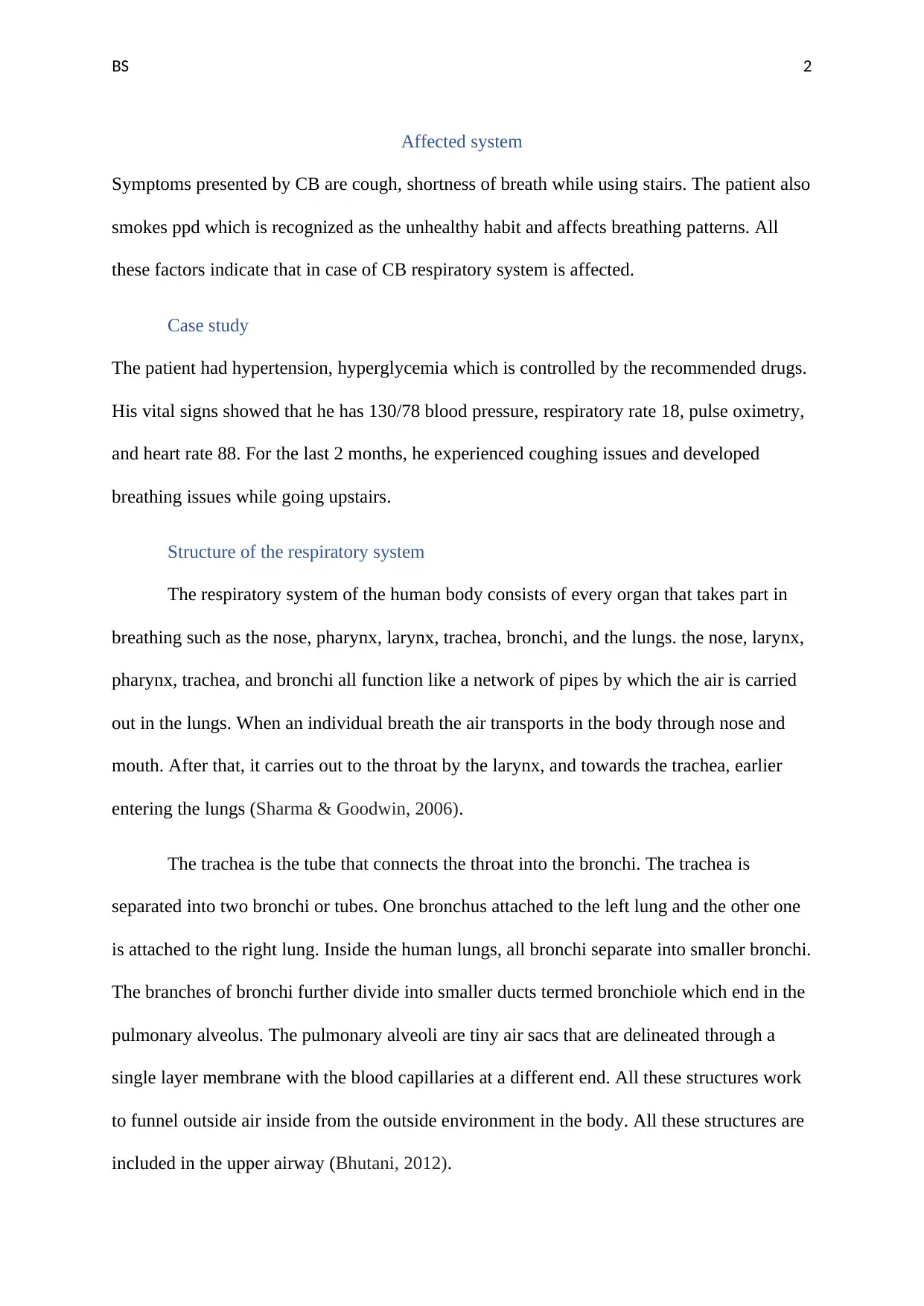
BS 2
Affected system
Symptoms presented by CB are cough, shortness of breath while using stairs. The patient also
smokes ppd which is recognized as the unhealthy habit and affects breathing patterns. All
these factors indicate that in case of CB respiratory system is affected.
Case study
The patient had hypertension, hyperglycemia which is controlled by the recommended drugs.
His vital signs showed that he has 130/78 blood pressure, respiratory rate 18, pulse oximetry,
and heart rate 88. For the last 2 months, he experienced coughing issues and developed
breathing issues while going upstairs.
Structure of the respiratory system
The respiratory system of the human body consists of every organ that takes part in
breathing such as the nose, pharynx, larynx, trachea, bronchi, and the lungs. the nose, larynx,
pharynx, trachea, and bronchi all function like a network of pipes by which the air is carried
out in the lungs. When an individual breath the air transports in the body through nose and
mouth. After that, it carries out to the throat by the larynx, and towards the trachea, earlier
entering the lungs (Sharma & Goodwin, 2006).
The trachea is the tube that connects the throat into the bronchi. The trachea is
separated into two bronchi or tubes. One bronchus attached to the left lung and the other one
is attached to the right lung. Inside the human lungs, all bronchi separate into smaller bronchi.
The branches of bronchi further divide into smaller ducts termed bronchiole which end in the
pulmonary alveolus. The pulmonary alveoli are tiny air sacs that are delineated through a
single layer membrane with the blood capillaries at a different end. All these structures work
to funnel outside air inside from the outside environment in the body. All these structures are
included in the upper airway (Bhutani, 2012).
Affected system
Symptoms presented by CB are cough, shortness of breath while using stairs. The patient also
smokes ppd which is recognized as the unhealthy habit and affects breathing patterns. All
these factors indicate that in case of CB respiratory system is affected.
Case study
The patient had hypertension, hyperglycemia which is controlled by the recommended drugs.
His vital signs showed that he has 130/78 blood pressure, respiratory rate 18, pulse oximetry,
and heart rate 88. For the last 2 months, he experienced coughing issues and developed
breathing issues while going upstairs.
Structure of the respiratory system
The respiratory system of the human body consists of every organ that takes part in
breathing such as the nose, pharynx, larynx, trachea, bronchi, and the lungs. the nose, larynx,
pharynx, trachea, and bronchi all function like a network of pipes by which the air is carried
out in the lungs. When an individual breath the air transports in the body through nose and
mouth. After that, it carries out to the throat by the larynx, and towards the trachea, earlier
entering the lungs (Sharma & Goodwin, 2006).
The trachea is the tube that connects the throat into the bronchi. The trachea is
separated into two bronchi or tubes. One bronchus attached to the left lung and the other one
is attached to the right lung. Inside the human lungs, all bronchi separate into smaller bronchi.
The branches of bronchi further divide into smaller ducts termed bronchiole which end in the
pulmonary alveolus. The pulmonary alveoli are tiny air sacs that are delineated through a
single layer membrane with the blood capillaries at a different end. All these structures work
to funnel outside air inside from the outside environment in the body. All these structures are
included in the upper airway (Bhutani, 2012).
⊘ This is a preview!⊘
Do you want full access?
Subscribe today to unlock all pages.

Trusted by 1+ million students worldwide
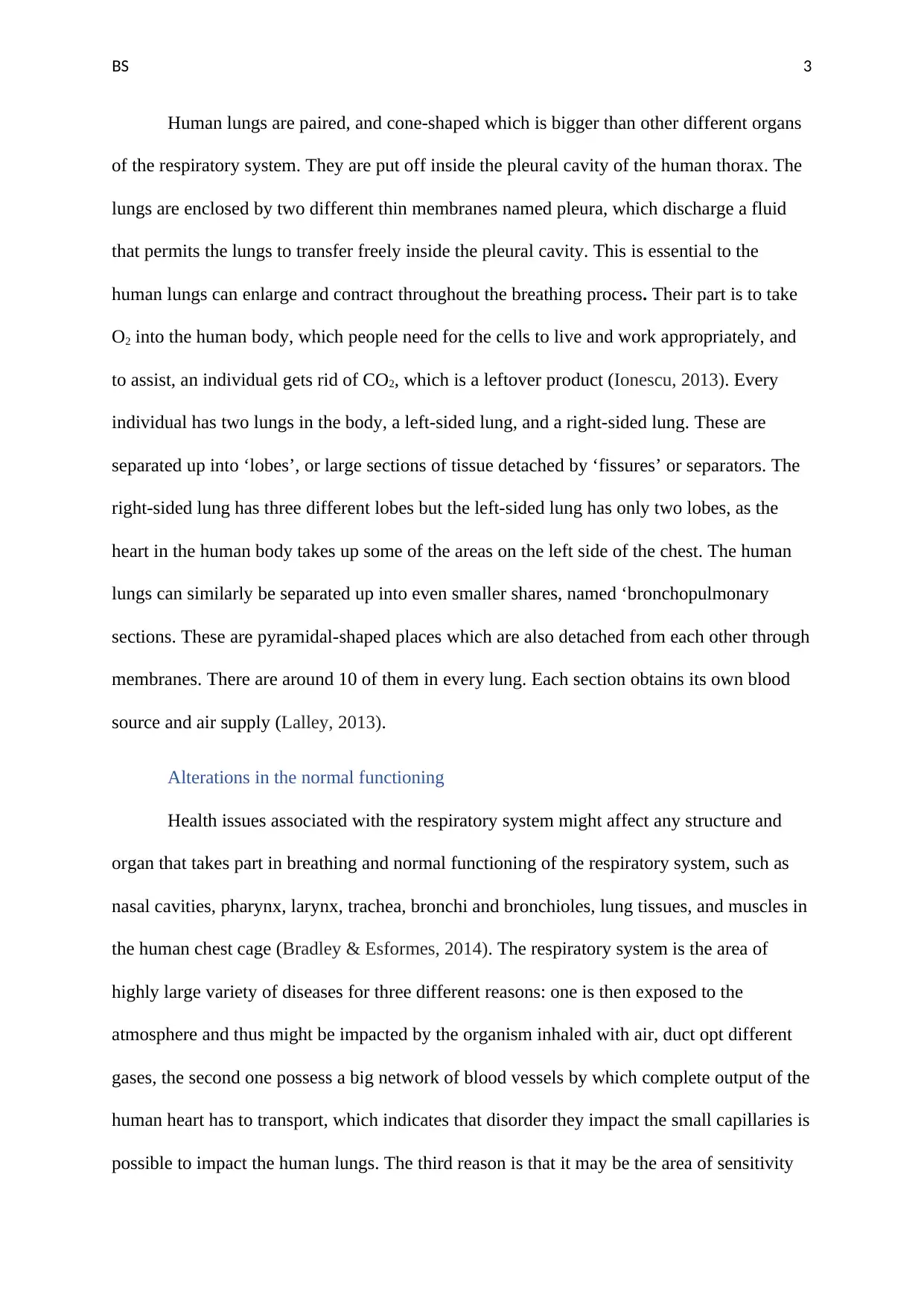
BS 3
Human lungs are paired, and cone-shaped which is bigger than other different organs
of the respiratory system. They are put off inside the pleural cavity of the human thorax. The
lungs are enclosed by two different thin membranes named pleura, which discharge a fluid
that permits the lungs to transfer freely inside the pleural cavity. This is essential to the
human lungs can enlarge and contract throughout the breathing process. Their part is to take
O2 into the human body, which people need for the cells to live and work appropriately, and
to assist, an individual gets rid of CO2, which is a leftover product (Ionescu, 2013). Every
individual has two lungs in the body, a left-sided lung, and a right-sided lung. These are
separated up into ‘lobes’, or large sections of tissue detached by ‘fissures’ or separators. The
right-sided lung has three different lobes but the left-sided lung has only two lobes, as the
heart in the human body takes up some of the areas on the left side of the chest. The human
lungs can similarly be separated up into even smaller shares, named ‘bronchopulmonary
sections. These are pyramidal-shaped places which are also detached from each other through
membranes. There are around 10 of them in every lung. Each section obtains its own blood
source and air supply (Lalley, 2013).
Alterations in the normal functioning
Health issues associated with the respiratory system might affect any structure and
organ that takes part in breathing and normal functioning of the respiratory system, such as
nasal cavities, pharynx, larynx, trachea, bronchi and bronchioles, lung tissues, and muscles in
the human chest cage (Bradley & Esformes, 2014). The respiratory system is the area of
highly large variety of diseases for three different reasons: one is then exposed to the
atmosphere and thus might be impacted by the organism inhaled with air, duct opt different
gases, the second one possess a big network of blood vessels by which complete output of the
human heart has to transport, which indicates that disorder they impact the small capillaries is
possible to impact the human lungs. The third reason is that it may be the area of sensitivity
Human lungs are paired, and cone-shaped which is bigger than other different organs
of the respiratory system. They are put off inside the pleural cavity of the human thorax. The
lungs are enclosed by two different thin membranes named pleura, which discharge a fluid
that permits the lungs to transfer freely inside the pleural cavity. This is essential to the
human lungs can enlarge and contract throughout the breathing process. Their part is to take
O2 into the human body, which people need for the cells to live and work appropriately, and
to assist, an individual gets rid of CO2, which is a leftover product (Ionescu, 2013). Every
individual has two lungs in the body, a left-sided lung, and a right-sided lung. These are
separated up into ‘lobes’, or large sections of tissue detached by ‘fissures’ or separators. The
right-sided lung has three different lobes but the left-sided lung has only two lobes, as the
heart in the human body takes up some of the areas on the left side of the chest. The human
lungs can similarly be separated up into even smaller shares, named ‘bronchopulmonary
sections. These are pyramidal-shaped places which are also detached from each other through
membranes. There are around 10 of them in every lung. Each section obtains its own blood
source and air supply (Lalley, 2013).
Alterations in the normal functioning
Health issues associated with the respiratory system might affect any structure and
organ that takes part in breathing and normal functioning of the respiratory system, such as
nasal cavities, pharynx, larynx, trachea, bronchi and bronchioles, lung tissues, and muscles in
the human chest cage (Bradley & Esformes, 2014). The respiratory system is the area of
highly large variety of diseases for three different reasons: one is then exposed to the
atmosphere and thus might be impacted by the organism inhaled with air, duct opt different
gases, the second one possess a big network of blood vessels by which complete output of the
human heart has to transport, which indicates that disorder they impact the small capillaries is
possible to impact the human lungs. The third reason is that it may be the area of sensitivity
Paraphrase This Document
Need a fresh take? Get an instant paraphrase of this document with our AI Paraphraser
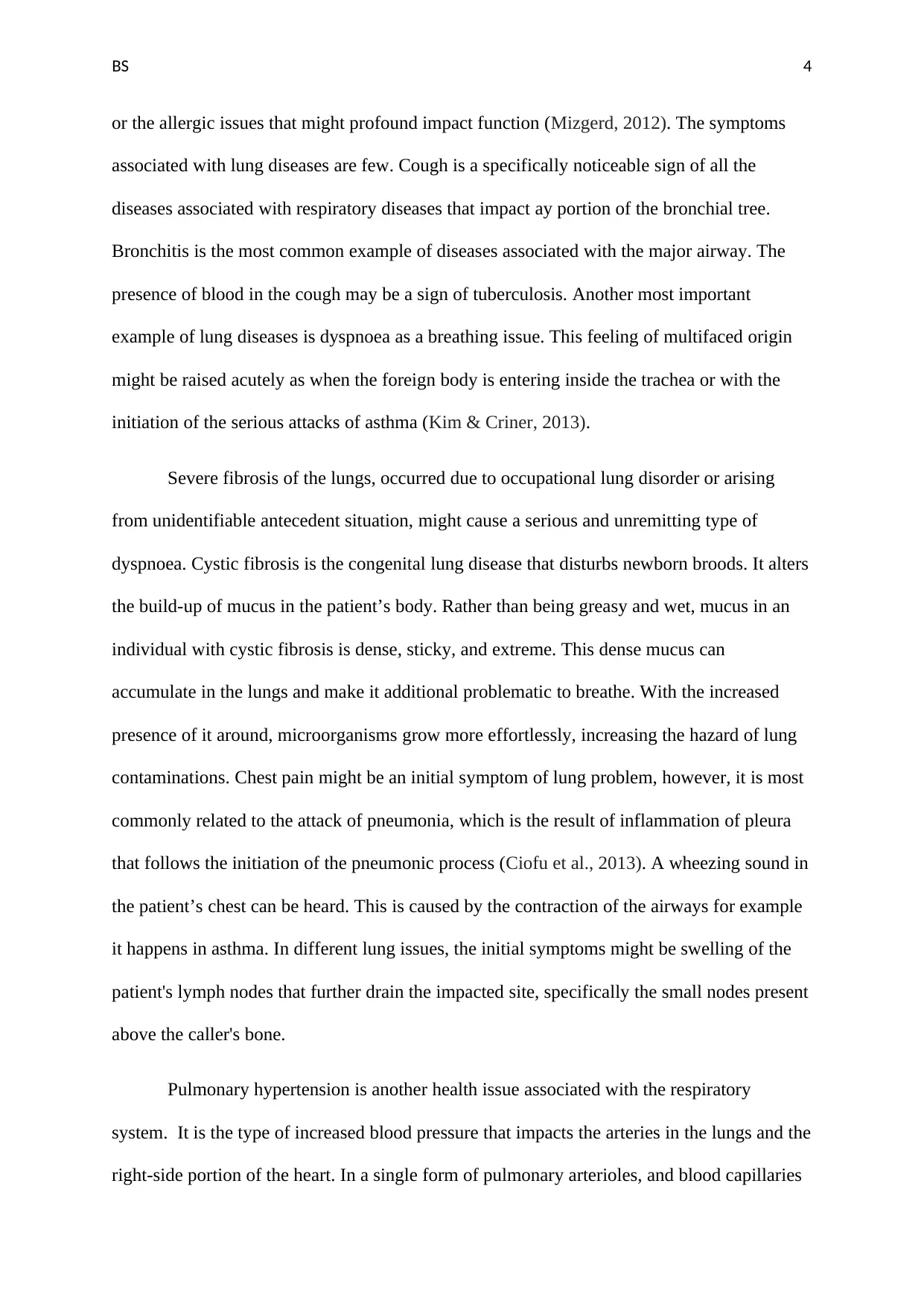
BS 4
or the allergic issues that might profound impact function (Mizgerd, 2012). The symptoms
associated with lung diseases are few. Cough is a specifically noticeable sign of all the
diseases associated with respiratory diseases that impact ay portion of the bronchial tree.
Bronchitis is the most common example of diseases associated with the major airway. The
presence of blood in the cough may be a sign of tuberculosis. Another most important
example of lung diseases is dyspnoea as a breathing issue. This feeling of multifaced origin
might be raised acutely as when the foreign body is entering inside the trachea or with the
initiation of the serious attacks of asthma (Kim & Criner, 2013).
Severe fibrosis of the lungs, occurred due to occupational lung disorder or arising
from unidentifiable antecedent situation, might cause a serious and unremitting type of
dyspnoea. Cystic fibrosis is the congenital lung disease that disturbs newborn broods. It alters
the build-up of mucus in the patient’s body. Rather than being greasy and wet, mucus in an
individual with cystic fibrosis is dense, sticky, and extreme. This dense mucus can
accumulate in the lungs and make it additional problematic to breathe. With the increased
presence of it around, microorganisms grow more effortlessly, increasing the hazard of lung
contaminations. Chest pain might be an initial symptom of lung problem, however, it is most
commonly related to the attack of pneumonia, which is the result of inflammation of pleura
that follows the initiation of the pneumonic process (Ciofu et al., 2013). A wheezing sound in
the patient’s chest can be heard. This is caused by the contraction of the airways for example
it happens in asthma. In different lung issues, the initial symptoms might be swelling of the
patient's lymph nodes that further drain the impacted site, specifically the small nodes present
above the caller's bone.
Pulmonary hypertension is another health issue associated with the respiratory
system. It is the type of increased blood pressure that impacts the arteries in the lungs and the
right-side portion of the heart. In a single form of pulmonary arterioles, and blood capillaries
or the allergic issues that might profound impact function (Mizgerd, 2012). The symptoms
associated with lung diseases are few. Cough is a specifically noticeable sign of all the
diseases associated with respiratory diseases that impact ay portion of the bronchial tree.
Bronchitis is the most common example of diseases associated with the major airway. The
presence of blood in the cough may be a sign of tuberculosis. Another most important
example of lung diseases is dyspnoea as a breathing issue. This feeling of multifaced origin
might be raised acutely as when the foreign body is entering inside the trachea or with the
initiation of the serious attacks of asthma (Kim & Criner, 2013).
Severe fibrosis of the lungs, occurred due to occupational lung disorder or arising
from unidentifiable antecedent situation, might cause a serious and unremitting type of
dyspnoea. Cystic fibrosis is the congenital lung disease that disturbs newborn broods. It alters
the build-up of mucus in the patient’s body. Rather than being greasy and wet, mucus in an
individual with cystic fibrosis is dense, sticky, and extreme. This dense mucus can
accumulate in the lungs and make it additional problematic to breathe. With the increased
presence of it around, microorganisms grow more effortlessly, increasing the hazard of lung
contaminations. Chest pain might be an initial symptom of lung problem, however, it is most
commonly related to the attack of pneumonia, which is the result of inflammation of pleura
that follows the initiation of the pneumonic process (Ciofu et al., 2013). A wheezing sound in
the patient’s chest can be heard. This is caused by the contraction of the airways for example
it happens in asthma. In different lung issues, the initial symptoms might be swelling of the
patient's lymph nodes that further drain the impacted site, specifically the small nodes present
above the caller's bone.
Pulmonary hypertension is another health issue associated with the respiratory
system. It is the type of increased blood pressure that impacts the arteries in the lungs and the
right-side portion of the heart. In a single form of pulmonary arterioles, and blood capillaries
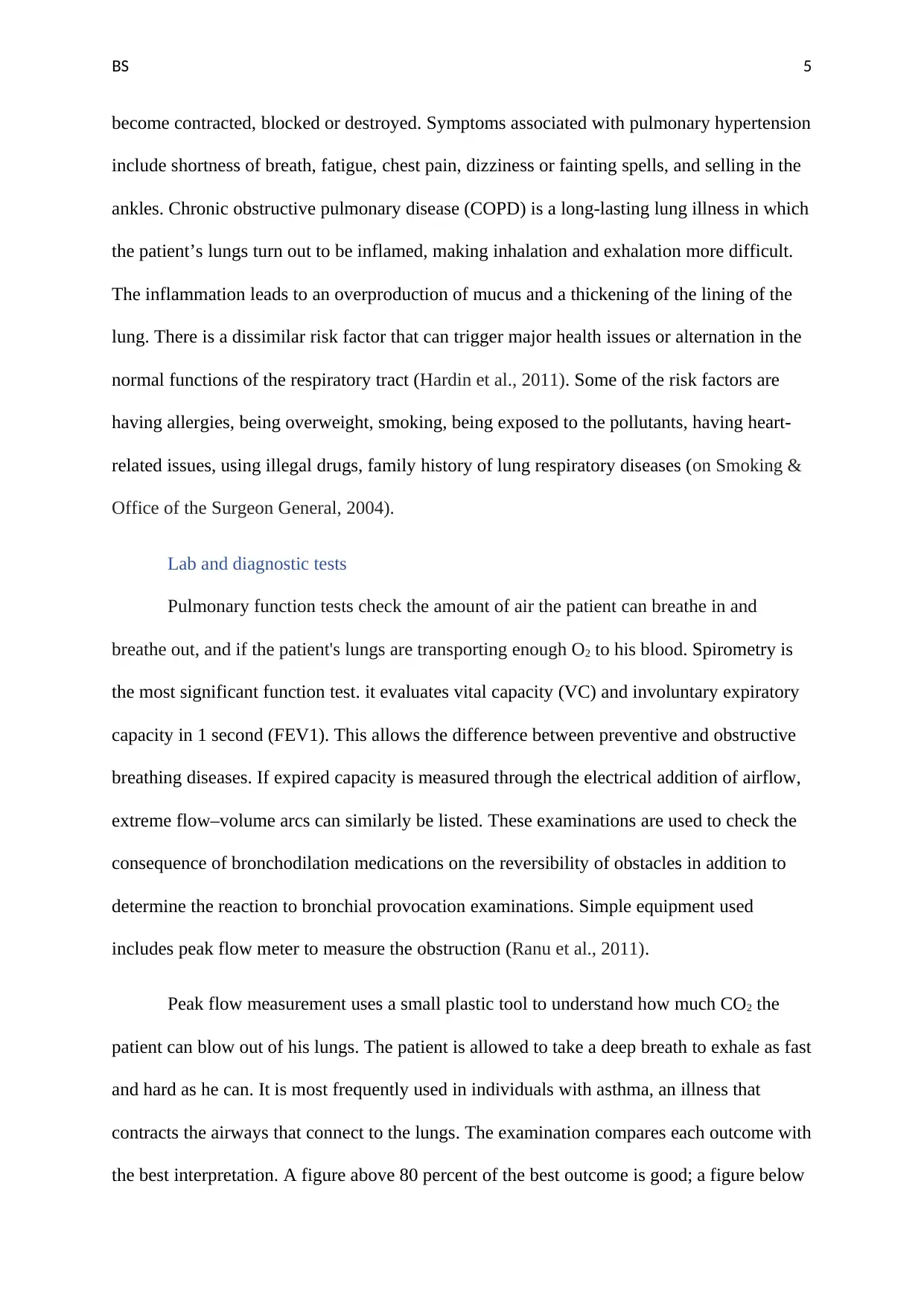
BS 5
become contracted, blocked or destroyed. Symptoms associated with pulmonary hypertension
include shortness of breath, fatigue, chest pain, dizziness or fainting spells, and selling in the
ankles. Chronic obstructive pulmonary disease (COPD) is a long-lasting lung illness in which
the patient’s lungs turn out to be inflamed, making inhalation and exhalation more difficult.
The inflammation leads to an overproduction of mucus and a thickening of the lining of the
lung. There is a dissimilar risk factor that can trigger major health issues or alternation in the
normal functions of the respiratory tract (Hardin et al., 2011). Some of the risk factors are
having allergies, being overweight, smoking, being exposed to the pollutants, having heart-
related issues, using illegal drugs, family history of lung respiratory diseases (on Smoking &
Office of the Surgeon General, 2004).
Lab and diagnostic tests
Pulmonary function tests check the amount of air the patient can breathe in and
breathe out, and if the patient's lungs are transporting enough O2 to his blood. Spirometry is
the most significant function test. it evaluates vital capacity (VC) and involuntary expiratory
capacity in 1 second (FEV1). This allows the difference between preventive and obstructive
breathing diseases. If expired capacity is measured through the electrical addition of airflow,
extreme flow–volume arcs can similarly be listed. These examinations are used to check the
consequence of bronchodilation medications on the reversibility of obstacles in addition to
determine the reaction to bronchial provocation examinations. Simple equipment used
includes peak flow meter to measure the obstruction (Ranu et al., 2011).
Peak flow measurement uses a small plastic tool to understand how much CO2 the
patient can blow out of his lungs. The patient is allowed to take a deep breath to exhale as fast
and hard as he can. It is most frequently used in individuals with asthma, an illness that
contracts the airways that connect to the lungs. The examination compares each outcome with
the best interpretation. A figure above 80 percent of the best outcome is good; a figure below
become contracted, blocked or destroyed. Symptoms associated with pulmonary hypertension
include shortness of breath, fatigue, chest pain, dizziness or fainting spells, and selling in the
ankles. Chronic obstructive pulmonary disease (COPD) is a long-lasting lung illness in which
the patient’s lungs turn out to be inflamed, making inhalation and exhalation more difficult.
The inflammation leads to an overproduction of mucus and a thickening of the lining of the
lung. There is a dissimilar risk factor that can trigger major health issues or alternation in the
normal functions of the respiratory tract (Hardin et al., 2011). Some of the risk factors are
having allergies, being overweight, smoking, being exposed to the pollutants, having heart-
related issues, using illegal drugs, family history of lung respiratory diseases (on Smoking &
Office of the Surgeon General, 2004).
Lab and diagnostic tests
Pulmonary function tests check the amount of air the patient can breathe in and
breathe out, and if the patient's lungs are transporting enough O2 to his blood. Spirometry is
the most significant function test. it evaluates vital capacity (VC) and involuntary expiratory
capacity in 1 second (FEV1). This allows the difference between preventive and obstructive
breathing diseases. If expired capacity is measured through the electrical addition of airflow,
extreme flow–volume arcs can similarly be listed. These examinations are used to check the
consequence of bronchodilation medications on the reversibility of obstacles in addition to
determine the reaction to bronchial provocation examinations. Simple equipment used
includes peak flow meter to measure the obstruction (Ranu et al., 2011).
Peak flow measurement uses a small plastic tool to understand how much CO2 the
patient can blow out of his lungs. The patient is allowed to take a deep breath to exhale as fast
and hard as he can. It is most frequently used in individuals with asthma, an illness that
contracts the airways that connect to the lungs. The examination compares each outcome with
the best interpretation. A figure above 80 percent of the best outcome is good; a figure below
⊘ This is a preview!⊘
Do you want full access?
Subscribe today to unlock all pages.

Trusted by 1+ million students worldwide
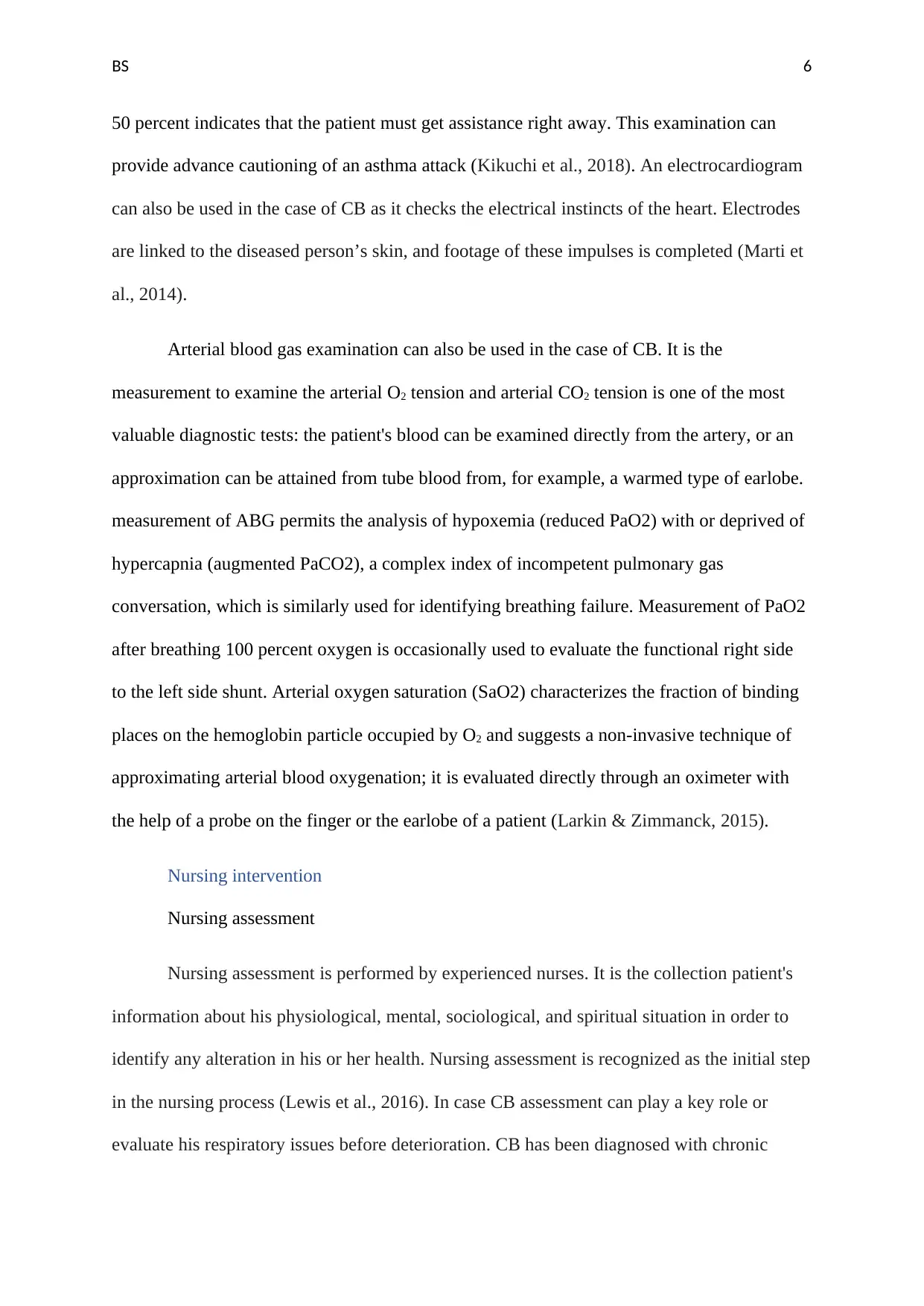
BS 6
50 percent indicates that the patient must get assistance right away. This examination can
provide advance cautioning of an asthma attack (Kikuchi et al., 2018). An electrocardiogram
can also be used in the case of CB as it checks the electrical instincts of the heart. Electrodes
are linked to the diseased person’s skin, and footage of these impulses is completed (Marti et
al., 2014).
Arterial blood gas examination can also be used in the case of CB. It is the
measurement to examine the arterial O2 tension and arterial CO2 tension is one of the most
valuable diagnostic tests: the patient's blood can be examined directly from the artery, or an
approximation can be attained from tube blood from, for example, a warmed type of earlobe.
measurement of ABG permits the analysis of hypoxemia (reduced PaO2) with or deprived of
hypercapnia (augmented PaCO2), a complex index of incompetent pulmonary gas
conversation, which is similarly used for identifying breathing failure. Measurement of PaO2
after breathing 100 percent oxygen is occasionally used to evaluate the functional right side
to the left side shunt. Arterial oxygen saturation (SaO2) characterizes the fraction of binding
places on the hemoglobin particle occupied by O2 and suggests a non-invasive technique of
approximating arterial blood oxygenation; it is evaluated directly through an oximeter with
the help of a probe on the finger or the earlobe of a patient (Larkin & Zimmanck, 2015).
Nursing intervention
Nursing assessment
Nursing assessment is performed by experienced nurses. It is the collection patient's
information about his physiological, mental, sociological, and spiritual situation in order to
identify any alteration in his or her health. Nursing assessment is recognized as the initial step
in the nursing process (Lewis et al., 2016). In case CB assessment can play a key role or
evaluate his respiratory issues before deterioration. CB has been diagnosed with chronic
50 percent indicates that the patient must get assistance right away. This examination can
provide advance cautioning of an asthma attack (Kikuchi et al., 2018). An electrocardiogram
can also be used in the case of CB as it checks the electrical instincts of the heart. Electrodes
are linked to the diseased person’s skin, and footage of these impulses is completed (Marti et
al., 2014).
Arterial blood gas examination can also be used in the case of CB. It is the
measurement to examine the arterial O2 tension and arterial CO2 tension is one of the most
valuable diagnostic tests: the patient's blood can be examined directly from the artery, or an
approximation can be attained from tube blood from, for example, a warmed type of earlobe.
measurement of ABG permits the analysis of hypoxemia (reduced PaO2) with or deprived of
hypercapnia (augmented PaCO2), a complex index of incompetent pulmonary gas
conversation, which is similarly used for identifying breathing failure. Measurement of PaO2
after breathing 100 percent oxygen is occasionally used to evaluate the functional right side
to the left side shunt. Arterial oxygen saturation (SaO2) characterizes the fraction of binding
places on the hemoglobin particle occupied by O2 and suggests a non-invasive technique of
approximating arterial blood oxygenation; it is evaluated directly through an oximeter with
the help of a probe on the finger or the earlobe of a patient (Larkin & Zimmanck, 2015).
Nursing intervention
Nursing assessment
Nursing assessment is performed by experienced nurses. It is the collection patient's
information about his physiological, mental, sociological, and spiritual situation in order to
identify any alteration in his or her health. Nursing assessment is recognized as the initial step
in the nursing process (Lewis et al., 2016). In case CB assessment can play a key role or
evaluate his respiratory issues before deterioration. CB has been diagnosed with chronic
Paraphrase This Document
Need a fresh take? Get an instant paraphrase of this document with our AI Paraphraser
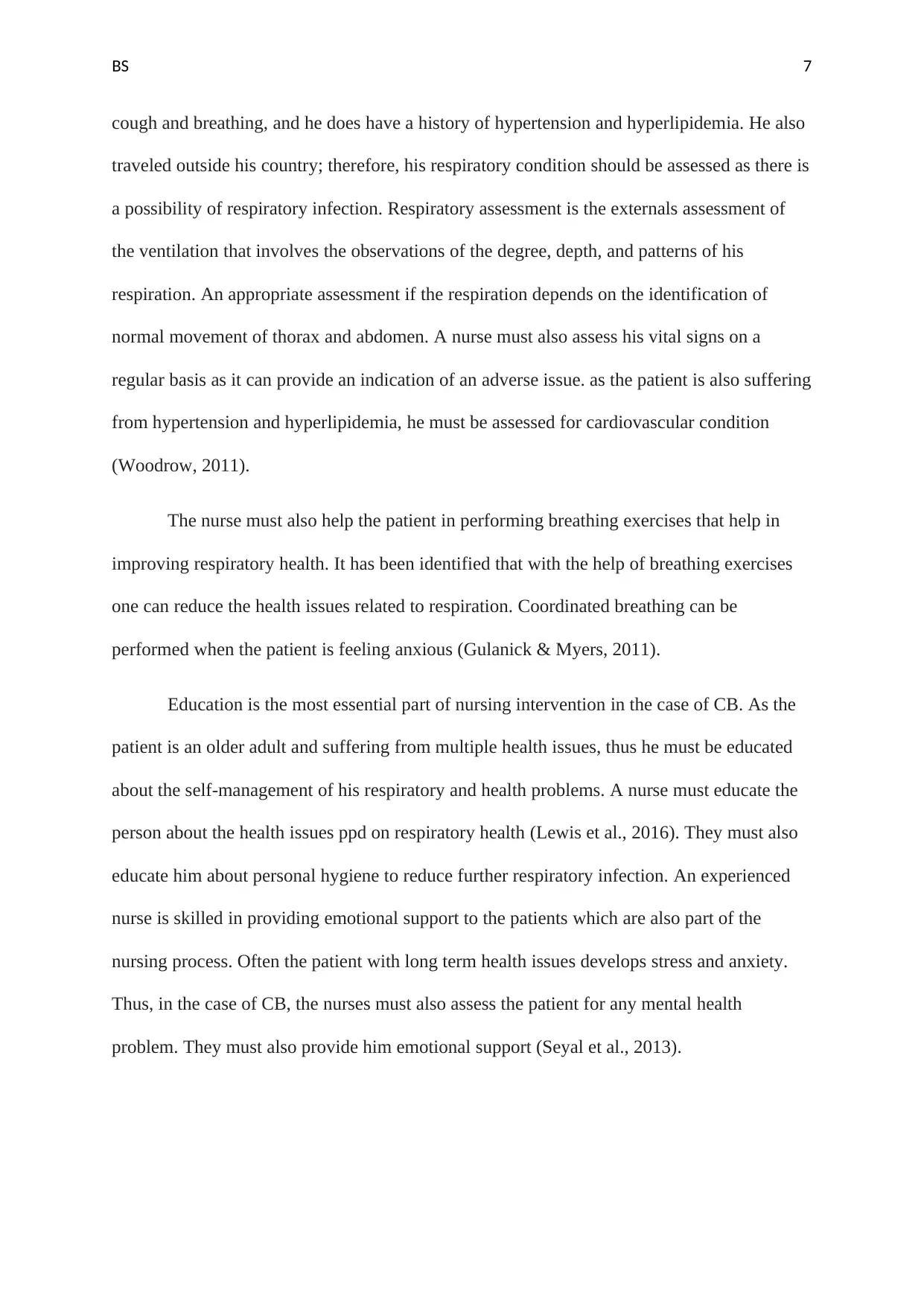
BS 7
cough and breathing, and he does have a history of hypertension and hyperlipidemia. He also
traveled outside his country; therefore, his respiratory condition should be assessed as there is
a possibility of respiratory infection. Respiratory assessment is the externals assessment of
the ventilation that involves the observations of the degree, depth, and patterns of his
respiration. An appropriate assessment if the respiration depends on the identification of
normal movement of thorax and abdomen. A nurse must also assess his vital signs on a
regular basis as it can provide an indication of an adverse issue. as the patient is also suffering
from hypertension and hyperlipidemia, he must be assessed for cardiovascular condition
(Woodrow, 2011).
The nurse must also help the patient in performing breathing exercises that help in
improving respiratory health. It has been identified that with the help of breathing exercises
one can reduce the health issues related to respiration. Coordinated breathing can be
performed when the patient is feeling anxious (Gulanick & Myers, 2011).
Education is the most essential part of nursing intervention in the case of CB. As the
patient is an older adult and suffering from multiple health issues, thus he must be educated
about the self-management of his respiratory and health problems. A nurse must educate the
person about the health issues ppd on respiratory health (Lewis et al., 2016). They must also
educate him about personal hygiene to reduce further respiratory infection. An experienced
nurse is skilled in providing emotional support to the patients which are also part of the
nursing process. Often the patient with long term health issues develops stress and anxiety.
Thus, in the case of CB, the nurses must also assess the patient for any mental health
problem. They must also provide him emotional support (Seyal et al., 2013).
cough and breathing, and he does have a history of hypertension and hyperlipidemia. He also
traveled outside his country; therefore, his respiratory condition should be assessed as there is
a possibility of respiratory infection. Respiratory assessment is the externals assessment of
the ventilation that involves the observations of the degree, depth, and patterns of his
respiration. An appropriate assessment if the respiration depends on the identification of
normal movement of thorax and abdomen. A nurse must also assess his vital signs on a
regular basis as it can provide an indication of an adverse issue. as the patient is also suffering
from hypertension and hyperlipidemia, he must be assessed for cardiovascular condition
(Woodrow, 2011).
The nurse must also help the patient in performing breathing exercises that help in
improving respiratory health. It has been identified that with the help of breathing exercises
one can reduce the health issues related to respiration. Coordinated breathing can be
performed when the patient is feeling anxious (Gulanick & Myers, 2011).
Education is the most essential part of nursing intervention in the case of CB. As the
patient is an older adult and suffering from multiple health issues, thus he must be educated
about the self-management of his respiratory and health problems. A nurse must educate the
person about the health issues ppd on respiratory health (Lewis et al., 2016). They must also
educate him about personal hygiene to reduce further respiratory infection. An experienced
nurse is skilled in providing emotional support to the patients which are also part of the
nursing process. Often the patient with long term health issues develops stress and anxiety.
Thus, in the case of CB, the nurses must also assess the patient for any mental health
problem. They must also provide him emotional support (Seyal et al., 2013).
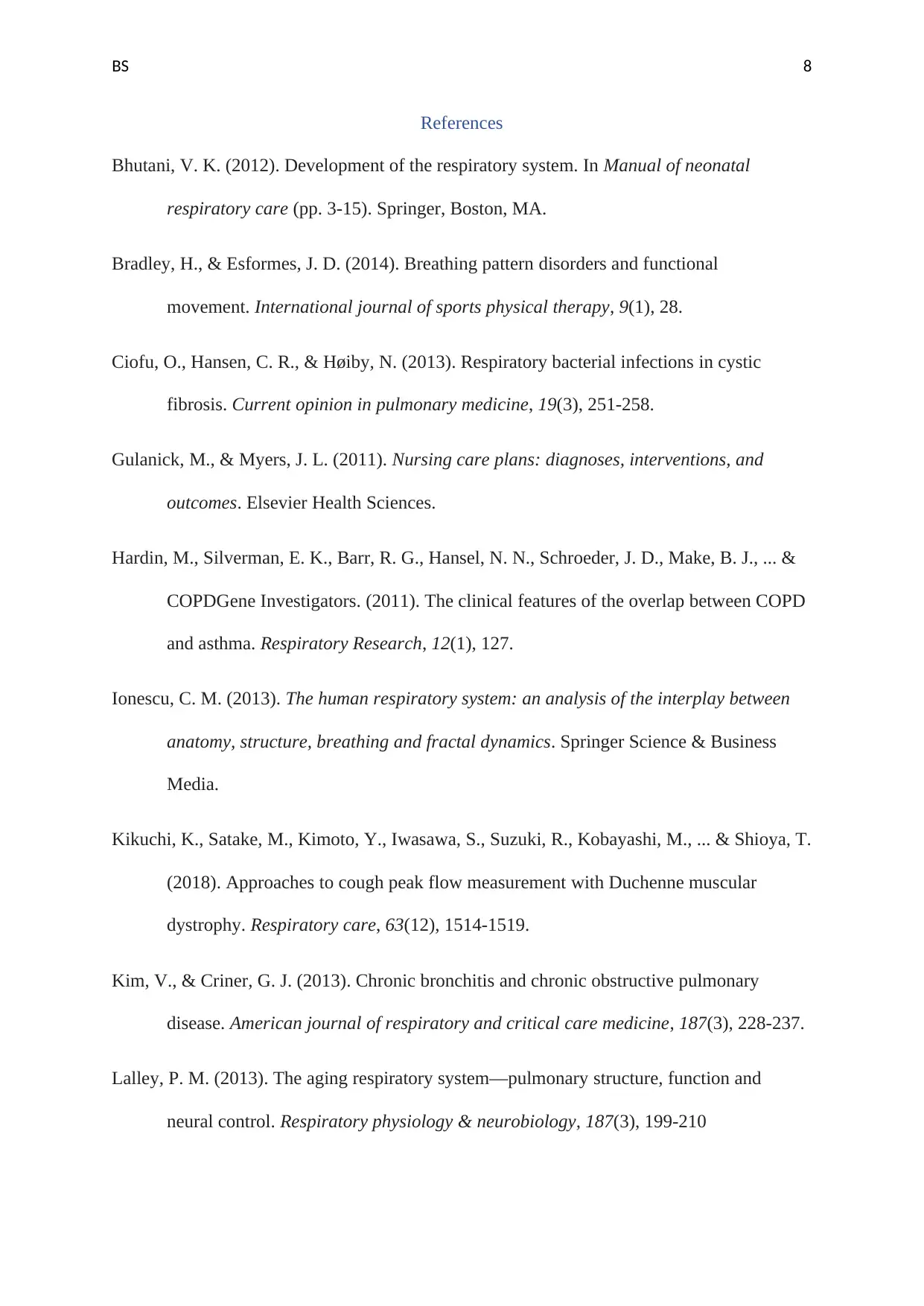
BS 8
References
Bhutani, V. K. (2012). Development of the respiratory system. In Manual of neonatal
respiratory care (pp. 3-15). Springer, Boston, MA.
Bradley, H., & Esformes, J. D. (2014). Breathing pattern disorders and functional
movement. International journal of sports physical therapy, 9(1), 28.
Ciofu, O., Hansen, C. R., & Høiby, N. (2013). Respiratory bacterial infections in cystic
fibrosis. Current opinion in pulmonary medicine, 19(3), 251-258.
Gulanick, M., & Myers, J. L. (2011). Nursing care plans: diagnoses, interventions, and
outcomes. Elsevier Health Sciences.
Hardin, M., Silverman, E. K., Barr, R. G., Hansel, N. N., Schroeder, J. D., Make, B. J., ... &
COPDGene Investigators. (2011). The clinical features of the overlap between COPD
and asthma. Respiratory Research, 12(1), 127.
Ionescu, C. M. (2013). The human respiratory system: an analysis of the interplay between
anatomy, structure, breathing and fractal dynamics. Springer Science & Business
Media.
Kikuchi, K., Satake, M., Kimoto, Y., Iwasawa, S., Suzuki, R., Kobayashi, M., ... & Shioya, T.
(2018). Approaches to cough peak flow measurement with Duchenne muscular
dystrophy. Respiratory care, 63(12), 1514-1519.
Kim, V., & Criner, G. J. (2013). Chronic bronchitis and chronic obstructive pulmonary
disease. American journal of respiratory and critical care medicine, 187(3), 228-237.
Lalley, P. M. (2013). The aging respiratory system—pulmonary structure, function and
neural control. Respiratory physiology & neurobiology, 187(3), 199-210
References
Bhutani, V. K. (2012). Development of the respiratory system. In Manual of neonatal
respiratory care (pp. 3-15). Springer, Boston, MA.
Bradley, H., & Esformes, J. D. (2014). Breathing pattern disorders and functional
movement. International journal of sports physical therapy, 9(1), 28.
Ciofu, O., Hansen, C. R., & Høiby, N. (2013). Respiratory bacterial infections in cystic
fibrosis. Current opinion in pulmonary medicine, 19(3), 251-258.
Gulanick, M., & Myers, J. L. (2011). Nursing care plans: diagnoses, interventions, and
outcomes. Elsevier Health Sciences.
Hardin, M., Silverman, E. K., Barr, R. G., Hansel, N. N., Schroeder, J. D., Make, B. J., ... &
COPDGene Investigators. (2011). The clinical features of the overlap between COPD
and asthma. Respiratory Research, 12(1), 127.
Ionescu, C. M. (2013). The human respiratory system: an analysis of the interplay between
anatomy, structure, breathing and fractal dynamics. Springer Science & Business
Media.
Kikuchi, K., Satake, M., Kimoto, Y., Iwasawa, S., Suzuki, R., Kobayashi, M., ... & Shioya, T.
(2018). Approaches to cough peak flow measurement with Duchenne muscular
dystrophy. Respiratory care, 63(12), 1514-1519.
Kim, V., & Criner, G. J. (2013). Chronic bronchitis and chronic obstructive pulmonary
disease. American journal of respiratory and critical care medicine, 187(3), 228-237.
Lalley, P. M. (2013). The aging respiratory system—pulmonary structure, function and
neural control. Respiratory physiology & neurobiology, 187(3), 199-210
⊘ This is a preview!⊘
Do you want full access?
Subscribe today to unlock all pages.

Trusted by 1+ million students worldwide
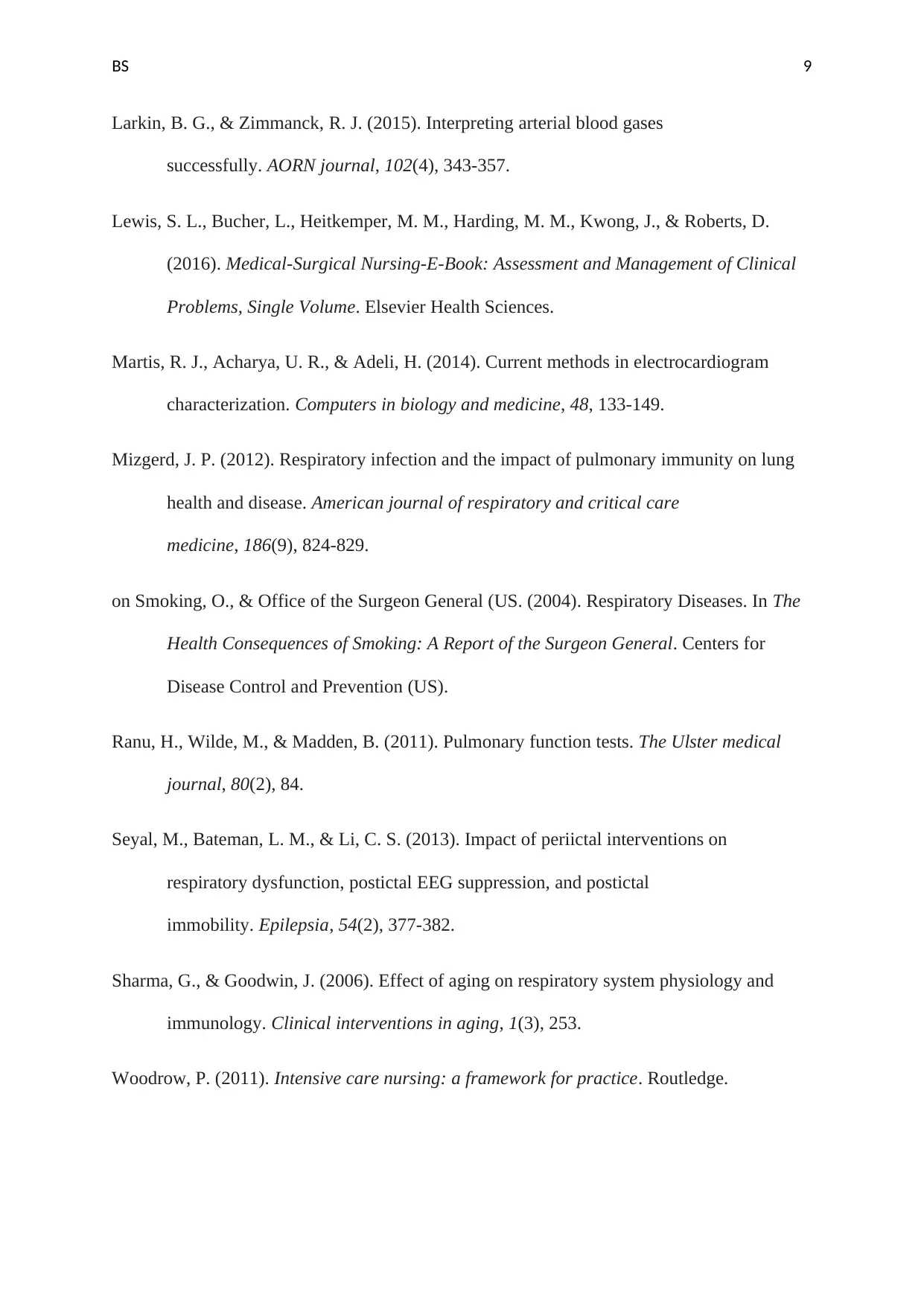
BS 9
Larkin, B. G., & Zimmanck, R. J. (2015). Interpreting arterial blood gases
successfully. AORN journal, 102(4), 343-357.
Lewis, S. L., Bucher, L., Heitkemper, M. M., Harding, M. M., Kwong, J., & Roberts, D.
(2016). Medical-Surgical Nursing-E-Book: Assessment and Management of Clinical
Problems, Single Volume. Elsevier Health Sciences.
Martis, R. J., Acharya, U. R., & Adeli, H. (2014). Current methods in electrocardiogram
characterization. Computers in biology and medicine, 48, 133-149.
Mizgerd, J. P. (2012). Respiratory infection and the impact of pulmonary immunity on lung
health and disease. American journal of respiratory and critical care
medicine, 186(9), 824-829.
on Smoking, O., & Office of the Surgeon General (US. (2004). Respiratory Diseases. In The
Health Consequences of Smoking: A Report of the Surgeon General. Centers for
Disease Control and Prevention (US).
Ranu, H., Wilde, M., & Madden, B. (2011). Pulmonary function tests. The Ulster medical
journal, 80(2), 84.
Seyal, M., Bateman, L. M., & Li, C. S. (2013). Impact of periictal interventions on
respiratory dysfunction, postictal EEG suppression, and postictal
immobility. Epilepsia, 54(2), 377-382.
Sharma, G., & Goodwin, J. (2006). Effect of aging on respiratory system physiology and
immunology. Clinical interventions in aging, 1(3), 253.
Woodrow, P. (2011). Intensive care nursing: a framework for practice. Routledge.
Larkin, B. G., & Zimmanck, R. J. (2015). Interpreting arterial blood gases
successfully. AORN journal, 102(4), 343-357.
Lewis, S. L., Bucher, L., Heitkemper, M. M., Harding, M. M., Kwong, J., & Roberts, D.
(2016). Medical-Surgical Nursing-E-Book: Assessment and Management of Clinical
Problems, Single Volume. Elsevier Health Sciences.
Martis, R. J., Acharya, U. R., & Adeli, H. (2014). Current methods in electrocardiogram
characterization. Computers in biology and medicine, 48, 133-149.
Mizgerd, J. P. (2012). Respiratory infection and the impact of pulmonary immunity on lung
health and disease. American journal of respiratory and critical care
medicine, 186(9), 824-829.
on Smoking, O., & Office of the Surgeon General (US. (2004). Respiratory Diseases. In The
Health Consequences of Smoking: A Report of the Surgeon General. Centers for
Disease Control and Prevention (US).
Ranu, H., Wilde, M., & Madden, B. (2011). Pulmonary function tests. The Ulster medical
journal, 80(2), 84.
Seyal, M., Bateman, L. M., & Li, C. S. (2013). Impact of periictal interventions on
respiratory dysfunction, postictal EEG suppression, and postictal
immobility. Epilepsia, 54(2), 377-382.
Sharma, G., & Goodwin, J. (2006). Effect of aging on respiratory system physiology and
immunology. Clinical interventions in aging, 1(3), 253.
Woodrow, P. (2011). Intensive care nursing: a framework for practice. Routledge.
Paraphrase This Document
Need a fresh take? Get an instant paraphrase of this document with our AI Paraphraser

BS 10
1 out of 11
Related Documents
Your All-in-One AI-Powered Toolkit for Academic Success.
+13062052269
info@desklib.com
Available 24*7 on WhatsApp / Email
![[object Object]](/_next/static/media/star-bottom.7253800d.svg)
Unlock your academic potential
Copyright © 2020–2025 A2Z Services. All Rights Reserved. Developed and managed by ZUCOL.





